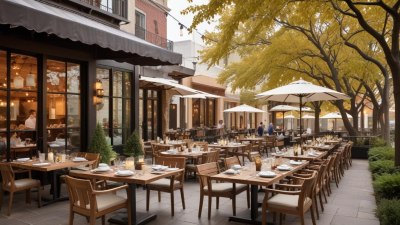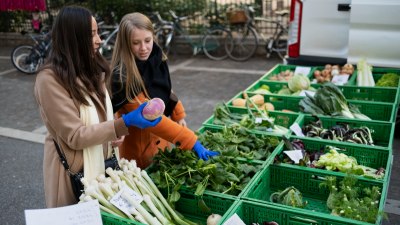Why Outdoor Dining Trends Follow the Weather Forecast
Explore how weather influences outdoor dining trends and customer preferences.

This image was created with the assistance of Freepik
Outdoor dining has become a significant aspect of the culinary experience, especially in urban settings where restaurants often seek ways to enhance their appeal and offer unique experiences. The relationship between outdoor dining trends and weather forecasts is a fascinating topic, illustrating how consumer behavior adapts to seasonal shifts and climate conditions. Understanding this dynamic is essential for restaurant owners, marketers, and food enthusiasts alike. In this exploration, we will delve into the various factors that illustrate why outdoor dining trends are closely intertwined with weather patterns.
The Impact of Seasonal Changes
As seasons change, so too does the dining behavior of consumers. Spring and summer months often see an uptick in outdoor dining as warmer weather encourages people to enjoy meals outside. In contrast, the fall and winter months can lead to a decline in such activities, as colder temperatures drive people indoors. For restaurants, this pattern means that planning menus, promotions, and ambiance must take seasonal variations into account. Utilizing space effectively is paramount; during warmer months, restaurants often expand their seating areas onto patios or sidewalks, while retracting these provisions as temperatures drop.
Weather and Mood
Weather has a significant impact on human mood, which in turn can influence dining choices. On sunny days, individuals often feel more upbeat and are more likely to seek out outdoor experiences, including dining. Studies have shown that sunlight and pleasant weather can boost serotonin levels, making individuals feel happier and more sociable. As such, restaurants benefit from this increase in foot traffic on sunny days, leading to sales boosts. Conversely, dreary, rainy weather typically sees a sales drop, as individuals opt to stay indoors rather than venture out for a meal.
Peak Dining Days
Certain weather conditions can create peak dining days, driving consumers to restaurants in greater numbers. For instance, the arrival of a warm spring day after a long winter can prompt a rush to outdoor dining venues. Similarly, holiday weekends that fall during pleasant weather often see packed patios and bustling sidewalks. Restaurants are wise to anticipate these peak days based on weather forecasts, ensuring they have adequate staff and supplies to handle the influx of patrons. Effective marketing strategies can capitalize on these opportunities, using promotions or social media to attract diners looking to enjoy the pleasant weather.
Menu Adjustments According to Weather
Restaurants often adapt their menus based on the weather, aligning their offerings with consumer desires linked to seasonal temperatures. Lighter, fresh dishes tend to fare well during warmer months, as diners crave refreshing foods like salads and grilled options. Conversely, fall and winter may usher in heartier, comfort food selections, such as soups and stews. By keeping an eye on the weather forecast, restaurants can make timely shifts to their menus, ensuring they meet customer expectations and preferences during varying seasons.
Ambiance and Outdoor Decor
The ambiance of outdoor dining spaces can significantly affect customer satisfaction and their willingness to enjoy a meal outside. Weather conditions impact how restaurants design their outdoor spaces; for instance, a sunny day may call for umbrellas and shaded areas, while cooler temperatures might prompt the use of outdoor heaters or cozy blankets. Enhanced outdoor decor and lighting can also transform a space, making it inviting regardless of the weather. Clear communication of weather-related accommodations, such as the availability of heaters or rain covers, can further entice customers to choose outdoor seating even when conditions are less than ideal.
Promotional Campaigns Linked to Weather
Restaurant marketers frequently leverage weather forecasts in their promotional strategies. By aligning social media campaigns to coincide with favorable weather predictions, they can entice diners to come out for outdoor meals. For example, a restaurant might promote a “Sunshine and Sangria” special on a day expected to be particularly sunny. Many establishments utilize local weather apps and social media channels to send real-time updates or special offers to their patrons, capturing attention and driving traffic when the weather supports outdoor dining.
Community Events and Outdoor Dining
Outdoor dining often intersects with community events such as festivals, fairs, and markets, which are frequently planned according to seasonal weather patterns. Restaurants that engage in local events or offer pop-up dining experiences during favorable weather increase both visibility and customer interaction. By participating in these community-focused gatherings, restaurants can build relationships and brand loyalty that extend well beyond just the meals they serve.
Sustainability and Outdoor Dining
As the culinary world increasingly embraces sustainability initiatives, outdoor dining trends are also evolving to reflect eco-friendly practices. Weather permits innovative outdoor dining options such as rooftop gardens, farm-to-table dining experiences, or use of local produce influenced by seasonal availability. Food establishments aim to attract environmentally conscious diners by showcasing their sustainable outdoor initiatives, aligning with the growing consumer demand for eco-friendly dining experiences.
Climate Change Considerations
The changing climate poses challenges and opportunities for outdoor dining establishments. As weather patterns become increasingly unpredictable, restaurants are forced to adapt not only in terms of daily operations but also long-term planning. For example, extreme heat days may lead to fewer patrons dining outdoors, pushing restaurants toward permanent solutions like shaded areas or misting systems. Similarly, businesses may need to rethink their outdoor seating capacity or invest in weather-resistant furniture. Understanding and preparing for these changes can help restaurants remain resilient and successful.
The relationship between outdoor dining trends and the weather forecast is complex yet fascinating. As consumer behavior shifts in response to changing climates, restaurants must remain agile and responsive to maximize their outdoor dining options. Understanding the nuances of how weather influences mood, dining preferences, and customer turnout is essential for creating memorable dining experiences. By embracing seasonal trends, leveraging effective marketing strategies, and ensuring a comfortable outdoor environment, restaurants can thrive, irrespective of weather conditions. As we continue to prioritize outdoor dining, understanding these dynamics will empower restaurants to innovate and cater to evolving consumer preferences.











